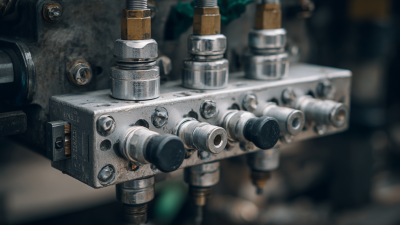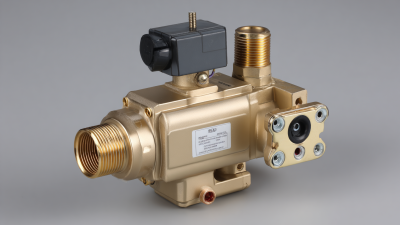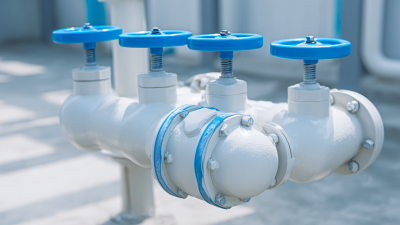Top Strategies for Enhancing Efficiency with Pneumatic Valves in Industrial Applications
In the ever-evolving landscape of industrial automation, the utilization of pneumatic valves has become increasingly critical for optimizing operational efficiency. According to a recent report by the International Energy Agency, industries that effectively integrate advanced pneumatic systems can achieve productivity increases of up to 20%. Pneumatic valves play a pivotal role in controlling airflow and pressure across various applications, ensuring precise operation in processes ranging from assembly lines to material handling. With the global pneumatic valve market projected to reach $7.2 billion by 2025, manufacturers must adopt best practices to enhance their performance and reliability. This blog will explore top strategies for leveraging pneumatic valves to boost efficiency, reduce downtime, and ultimately drive cost savings in industrial environments.

Identifying Common Issues with Pneumatic Valves in Industrial Settings
Pneumatic valves are critical components in industrial applications, but they often face several common issues that can impede their efficiency. One of the primary problems is valve leakage, which can occur due to wear and tear or improper installation. Such leaks can lead to a significant loss of air pressure, reducing the overall performance of pneumatic systems. Regular maintenance and timely replacements of seals and gaskets are essential to mitigate these risks and maintain optimal functionality.
Another prevalent issue is valve sticking, typically caused by dirt or debris collected within the valve mechanism. This sticking can disrupt the flow of air, leading to delays in operation and inefficient system performance. Implementing proper filtration systems can help prevent contaminants from entering the valve, enhancing its reliability. Additionally, adopting routine cleaning protocols ensures that valves operate smoothly, further reducing the likelihood of operational downtime. By identifying and addressing these common issues, industries can significantly improve the efficiency of their pneumatic systems.
Understanding the Impact of Malfunctioning Pneumatic Valves on Efficiency
Malfunctioning pneumatic valves can significantly disrupt industrial efficiency, leading to costly downtime and decreased productivity. According to a report by the National Institute of Standards and Technology (NIST), unpredicted failures in pneumatic systems can contribute to up to 20% of total operational downtime in manufacturing environments. This statistic highlights the critical importance of maintaining high-functioning pneumatic valves to ensure seamless operations.
Furthermore, a study by the Fluid Power Society found that improperly calibrated valves can result in energy losses of around 15%, affecting both the cost-effectiveness and environmental sustainability of industrial processes. These energy inefficiencies not only inflate operational costs but also add to the carbon footprint of manufacturing sites, as systems struggle to compensate for inadequate valve performance. Therefore, investing in quality pneumatic valves and regular maintenance is essential for optimizing efficiency and minimizing the risk of malfunctions that lead to extensive financial repercussions.

Best Practices for Troubleshooting Pneumatic Valve Problems
When it comes to troubleshooting pneumatic valve problems in industrial applications, a systematic approach is essential for maintaining efficiency and minimizing downtime. First, always check for air leaks around the valve components. Small leaks can significantly impact performance, leading to inconsistent operations and increased energy costs. Utilize soap solutions or an ultrasonic leak detector to identify and resolve these issues promptly.
Another critical aspect is to ensure that the pneumatic valves are receiving clean, dry air. Contaminants such as moisture or particulate matter can lead to valve malfunction. Regularly inspect and replace filters as needed, and consider implementing a comprehensive maintenance schedule that includes periodic disassembly and cleaning of the valve internals.
Finally, monitor the control signals sent to the valves. Improper voltage or signal interruptions can cause erratic behavior. Test the control circuits and use diagnostic tools to confirm that the signals are within the desired parameters. By following these tips, you can enhance the operational efficiency of pneumatic valves and address problems before they escalate into significant issues.
Top Strategies for Enhancing Efficiency with Pneumatic Valves
This chart illustrates the potential efficiency improvements (%) in various best practices for enhancing pneumatic valves in industrial applications. By focusing on strategies like regular maintenance and the use of quality components, industries can significantly boost operational performance.
Innovative Solutions to Enhance Pneumatic Valve Performance
In the rapidly evolving industrial landscape, enhancing the performance of pneumatic valves is critical for optimizing efficiency across multiple applications. The global pneumatic components market, projected to grow from USD 19.49 billion in 2024 to USD 27.02 billion by 2030, highlights the increasing demand for innovative solutions that improve pneumatic valve functionality. These valves play a vital role in various processes, from automotive systems to manufacturing automation, and their performance directly impacts overall system efficiency.
To maximize the effectiveness of pneumatic valves, consider implementing advanced surface modification techniques. These techniques can enhance the durability and responsiveness of the valves, leading to significant performance gains. For instance, employing coatings designed to reduce friction can minimize wear and tear, thereby prolonging the lifespan of the components.
**Tips:** Regular maintenance and inspection of pneumatic systems can identify potential issues before they escalate. Additionally, investing in high-quality pneumatic valves and components ensures reliability and consistent performance. Furthermore, exploring emerging technologies in electrohydraulic pressure control can provide a competitive edge by creating more responsive and efficient systems, addressing the current challenges faced in valve technology.
Maintenance Tips to Prevent Pneumatic Valve Failures and Downtime
Pneumatic valves play a crucial role in industrial automation and fluid control systems, and their reliability directly impacts operational efficiency. Preventing pneumatic valve failures requires a robust maintenance routine, as statistics indicate that approximately 30% of unexpected downtime in manufacturing is attributed to equipment failures, including valve malfunctions. Regular inspection of pneumatic valves can help identify wear and tear or signs of contamination. Implementing a predictive maintenance program based on industry benchmarks can reduce these failures by an estimated 25%.

Furthermore, lubrication and cleanliness are vital maintenance tips that significantly enhance valve lifespan. According to a report by the International Society of Automation, proper lubrication can increase the operational life of pneumatic valves by up to 50%. Additionally, maintaining clean air supply and regularly replacing filters can prevent particulate matter from damaging valve components. By prioritizing these maintenance strategies, industrial operations can minimize downtime and enhance productivity, ultimately leading to improved profitability and system performance.
Related Posts
-

How to Select the Best Pneumatic Valve for Your Industrial Applications
-

7 Effective Strategies for Choosing the Right Electric Valve
-

Discover Top Quality Electric Valves from Leading Manufacturers in China
-

What Defines an Actuated Ball Valve and Its Importance in Industrial Applications
-

What Makes the Best PVC Ball Valve Ideal for Your Business Needs
-

Mastering the Basics of 3 Way Ball Valve Installation and Maintenance Guide
